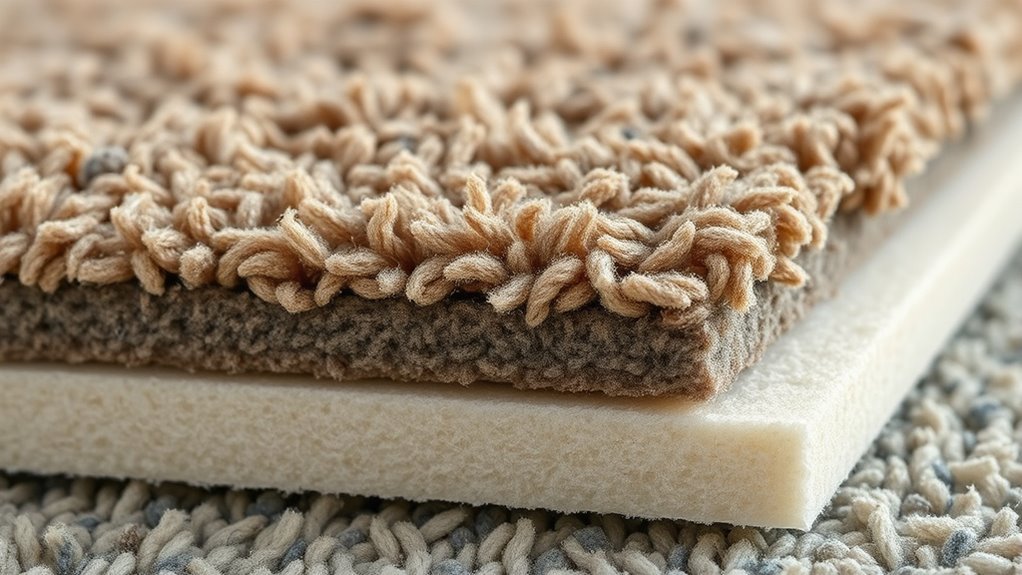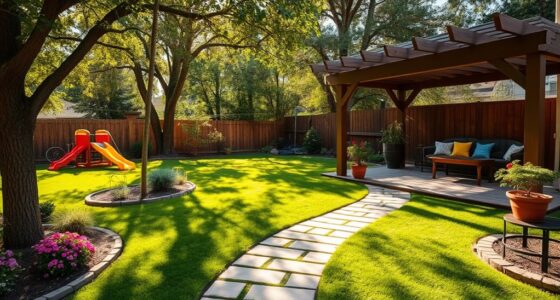To control sound between floors, choose thick, plush carpets with higher pile and density, which absorb impact noise effectively. Pair them with appropriate pads made of foam, rubber, or felt to further dampen sounds and improve comfort. Installing underlayments beneath the carpets enhances soundproofing by reducing airborne and impact noise. Combining these materials creates an extensive system that can considerably minimize noise transmission. If you want to learn about more ways to improve your floor soundproofing, keep exploring.
Key Takeaways
- Carpets absorb impact noise and reduce echo, especially thicker, plush options with higher pile height.
- Carpet pads made from foam or rubber enhance impact noise dampening and improve comfort underfoot.
- Underlayments beneath carpets and pads block airborne and impact sounds, boosting overall soundproofing.
- Combining carpets, pads, and underlayments creates an effective system to minimize noise transmission between floors.
- Proper installation and quality materials are essential for maximizing sound control benefits.

Have you ever been disturbed by noise traveling between floors in your home? If so, you’re not alone. Floors can be a major source of sound transfer, especially in multi-story homes where footsteps, dropped objects, or even conversations can echo through the space. Fortunately, there are effective ways to minimize these sounds, and one of the most straightforward solutions involves using carpets, pads, and underlay. These materials can dramatically improve sound insulation, creating a quieter, more peaceful environment.
Carpets are a popular choice because they add a soft barrier that absorbs impact noise. When you walk across a carpeted surface, the fibers help dampen the sound of your footsteps, preventing it from bouncing into the floor below. Thick, plush carpets are especially good at reducing noise, but even thinner options can offer some sound absorption. Keep in mind that the density and pile height of the carpet influence how much sound it can dampen. The denser and taller the pile, the better it tends to absorb sound. Installing a quality carpet can make a noticeable difference in reducing footstep noise and other everyday sounds.
Beneath the carpet, a pad or cushioning layer enhances soundproofing further. Carpet pads are usually made from foam, rubber, or felt materials, and they serve multiple purposes. Besides improving comfort underfoot, they act as a buffer that absorbs impact noise and muffles sounds traveling through the floor. When choosing a pad, opt for one with good density and thickness, as these qualities determine how well it dampens sound. Thicker, denser pads tend to provide better noise reduction, especially in homes with high foot traffic.
Underlayments are another essential component in controlling sound between floors. These are typically thin layers placed underneath the carpet and padding, serving as a barrier to sound transmission. Acoustic underlayments, often made from specialized foam or rubber, are designed specifically to block airborne and impact noise. When installed properly, underlayments can markedly reduce the amount of sound that travels through the floor structure. They are especially useful in apartments or multi-family homes where sound privacy is a priority. Combining an underlay with a suitable carpet and pad creates an all-encompassing soundproofing system that minimizes noise transfer effectively.
Frequently Asked Questions
How Effective Are Rugs Compared to Specialized Soundproofing Materials?
Rugs are somewhat effective at reducing noise, but they don’t match the soundproofing power of specialized materials. While rugs absorb some impact sound and can dampen footsteps, they don’t block airborne noise as well as soundproofing mats, underlays, or acoustic panels. If you need significant sound control, investing in dedicated soundproofing products will give you much better results than rugs alone.
Can Soundproof Underlays Be Used Beneath All Types of Flooring?
Yes, soundproof underlays can be used beneath almost any flooring, transforming your space into a fortress of silence. Imagine silencing footsteps, echoes, and noisy neighbors with one simple layer—it’s like magic! Whether you’re installing laminate, hardwood, or vinyl, these underlays dramatically reduce sound transmission. Just make sure to check compatibility, and you’ll enjoy a peaceful, quiet environment that’s almost too good to be true.
What Maintenance Is Required for Sound-Absorbing Carpets and Pads?
You should regularly vacuum your sound-absorbing carpets and pads to remove dirt and debris that can reduce their effectiveness. Additionally, check for any signs of wear or damage, such as fraying or compression, and replace or repair as needed. Keep the area well-ventilated to prevent mold or mildew buildup, especially if there’s any moisture. Periodic deep cleaning or professional maintenance can also help maintain their soundproofing properties.
Are There Eco-Friendly Options for Soundproofing Between Floors?
Like Pandora’s box of eco-friendly choices, you’ll find options that help soundproof floors while caring for the environment. You can opt for natural wool carpets, cork underlays, or recycled rubber pads. These materials absorb sound effectively and are sustainable. By choosing eco-friendly soundproofing, you not only reduce noise but also contribute to a greener planet. It’s a win-win, making your home quieter and more Earth-conscious.
How Do Different Flooring Materials Impact Sound Transmission?
Different flooring materials affect sound transmission in various ways. Carpets with thick padding absorb sound, reducing noise between floors. Hardwood and laminate floors tend to transmit more sound unless paired with underlayments or rugs. Vinyl and cork offer better sound insulation naturally, while concrete floors transmit sound more readily unless treated with soundproofing layers. Your choice depends on balancing durability, aesthetics, and noise reduction needs for your space.
Conclusion
To reduce noise between floors, using carpets, pads, or underlay can make a big difference. In fact, adding a quality underlay can cut noise transfer by up to 70%. So, next time you’re considering flooring options, remember that simple choices like these can considerably improve your home’s comfort. Don’t underestimate the power of these small upgrades—they create quieter, more peaceful living spaces for you and your family.









